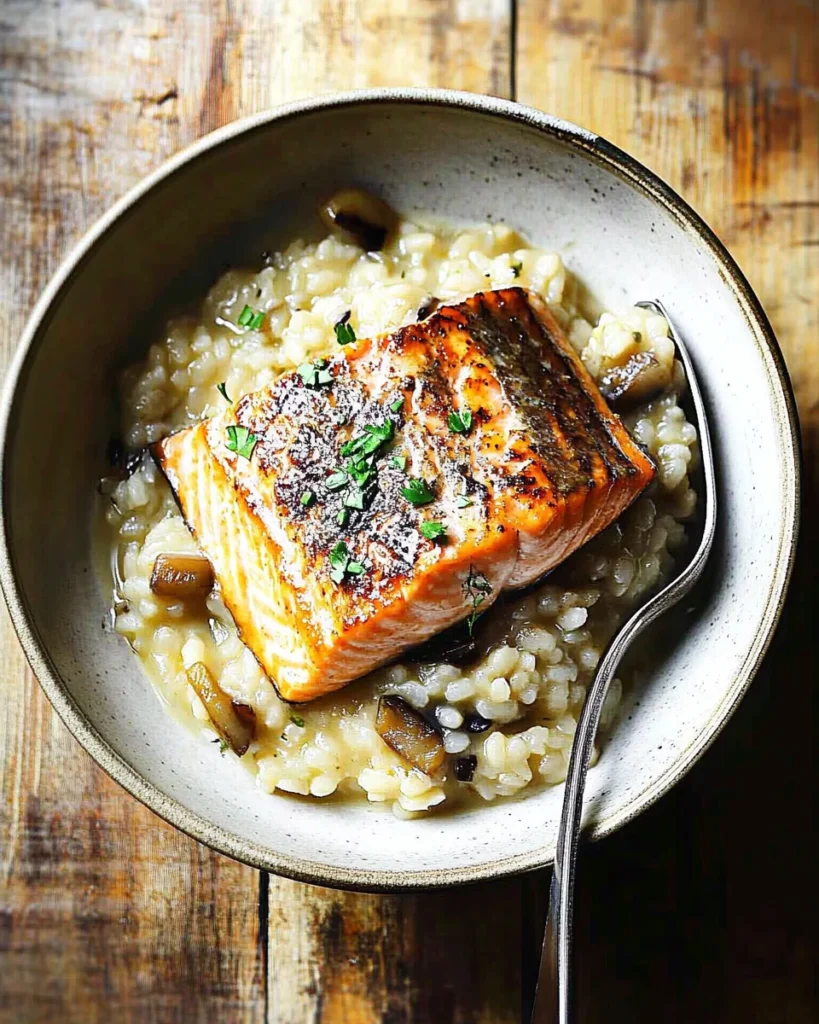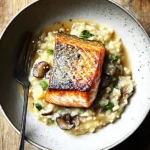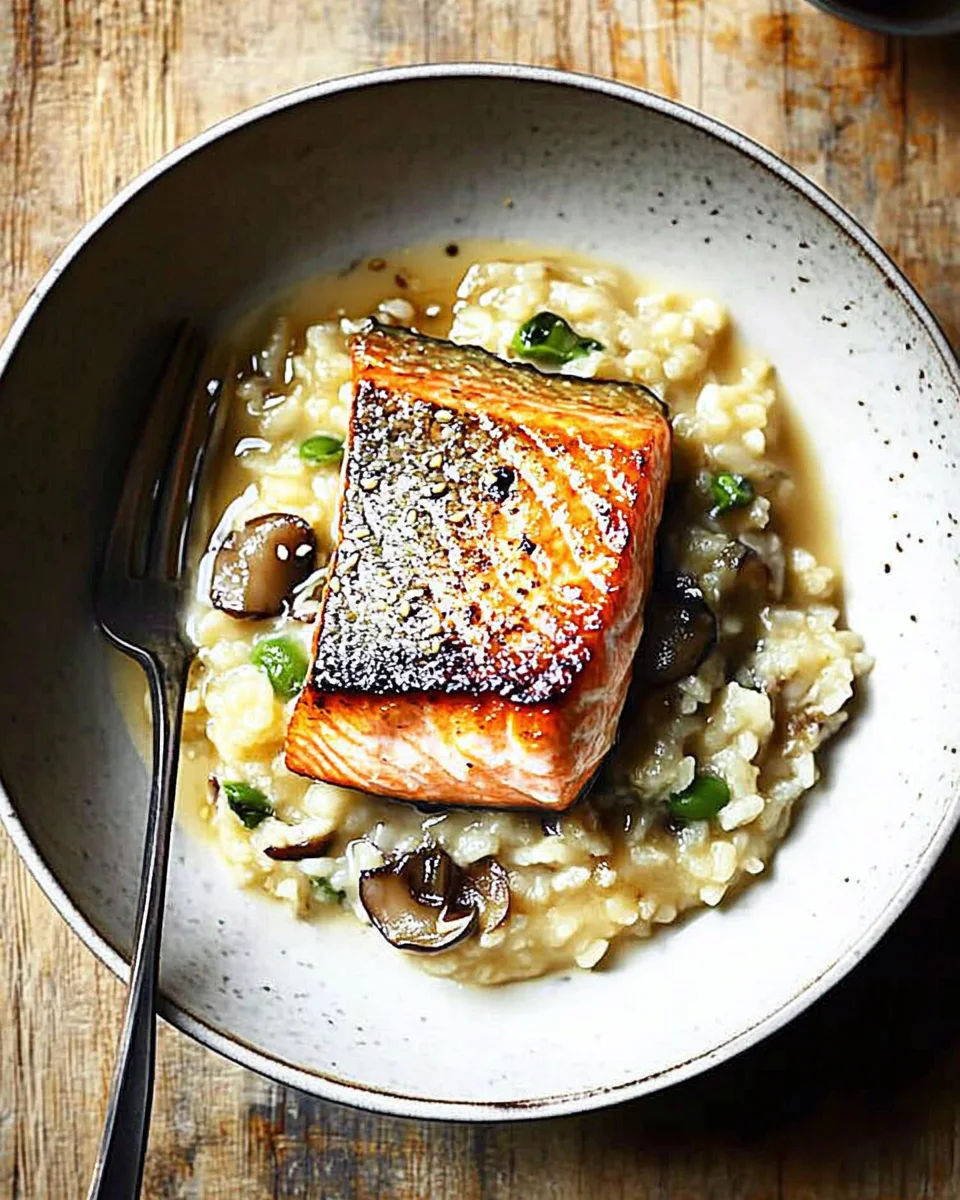Introduction to Seared Salmon with Japanese Risotto
Seared Salmon with Japanese Risotto is a delightful dish that brings together the best of two culinary worlds. This recipe combines the rich, buttery flavor of perfectly seared salmon with the creamy, umami-packed essence of Japanese-style risotto. The result is a meal that is not only satisfying but also visually stunning, making it perfect for both weeknight dinners and special occasions.
What Makes Seared Salmon with Japanese Risotto Unique?
What sets this dish apart is its unique blend of textures and flavors. The salmon, with its crispy skin and tender flesh, contrasts beautifully with the creamy risotto. The sushi rice used in the risotto absorbs the flavors of the broth and seasonings, creating a comforting base. Additionally, the inclusion of ingredients like shiitake mushrooms and edamame adds depth and a touch of earthiness, making each bite a delightful experience.
Moreover, the use of traditional Japanese ingredients such as soy sauce and mirin elevates the dish, giving it a distinct flavor profile that is both familiar and exotic. This fusion of flavors not only excites the palate but also showcases the versatility of salmon, making it a star ingredient in this recipe.
The Cultural Fusion of Flavors
The cultural fusion in Seared Salmon with Japanese Risotto is a celebration of culinary creativity. Japanese cuisine is known for its emphasis on fresh ingredients and delicate flavors, while Italian risotto is celebrated for its creamy texture and rich taste. By merging these two styles, this dish offers a unique dining experience that highlights the best of both worlds.
As you savor each bite, you’ll notice how the flavors harmonize beautifully. The savory notes from the soy sauce and the sweetness of mirin complement the natural richness of the salmon. This dish not only satisfies hunger but also invites you to explore the delightful interplay of different culinary traditions. It’s a perfect example of how food can bring cultures together, creating something truly special.
Ingredients for Seared Salmon with Japanese Risotto
To create the delicious Seared Salmon with Japanese Risotto, you will need a variety of fresh and flavorful ingredients. Each component plays a vital role in building the dish’s unique taste and texture. Here’s a complete list of what you’ll need:
- 2 cups sushi rice: This short-grain rice is essential for achieving the creamy texture of the risotto.
- 4 cups low-sodium chicken broth: Using low-sodium broth allows you to control the saltiness of the dish while adding depth of flavor.
- 1 tablespoon olive oil: This oil is used for sautéing and adds a light, fruity flavor.
- 1 tablespoon unsalted butter: Butter enriches the risotto, giving it a creamy finish.
- 1 small onion, finely chopped: The onion adds sweetness and depth to the dish.
- 2 cloves garlic, minced: Garlic brings a wonderful aroma and flavor to the risotto.
- 1 cup shiitake mushrooms, sliced: These mushrooms add an earthy flavor and a nice texture.
- 1 cup edamame, shelled: Edamame provides a pop of color and a boost of protein.
- 2 tablespoons soy sauce: This ingredient adds umami and saltiness to the dish.
- 1 tablespoon mirin: Mirin is a sweet rice wine that enhances the overall flavor.
- 1 teaspoon sesame oil: This oil adds a nutty aroma and flavor, tying the dish together.
- 4 salmon fillets (about 6 ounces each): Fresh salmon is the star of the dish, providing rich flavor and healthy fats.
- Salt and pepper to taste: Essential for seasoning the salmon and risotto.
- 2 green onions, sliced (for garnish): These add a fresh crunch and vibrant color.
- Sesame seeds (for garnish): Toasted sesame seeds provide a delightful crunch and visual appeal.
Gathering these ingredients will set you on the right path to creating a delicious meal that is sure to impress. Each element contributes to the overall harmony of flavors, making this dish a true culinary delight.
Step-by-Step Preparation of Seared Salmon with Japanese Risotto
Now that you have all your ingredients ready, it’s time to dive into the cooking process. This step-by-step guide will help you create the perfect Seared Salmon with Japanese Risotto. Follow these simple instructions to ensure a delicious outcome!
Step 1: Preparing the Ingredients
Preparation is key to a smooth cooking experience. Start by rinsing the sushi rice under cold water. This step removes excess starch, ensuring your risotto has the right texture. Keep rinsing until the water runs clear, then drain the rice well.
Next, finely chop the onion and mince the garlic. Slice the shiitake mushrooms and set them aside. If you’re using frozen edamame, make sure to thaw them beforehand. Having everything prepped will make the cooking process much easier and faster.
Step 2: Cooking the Japanese Risotto
In a medium saucepan, combine the rinsed sushi rice and low-sodium chicken broth. Bring the mixture to a boil over medium-high heat. Once boiling, reduce the heat to low, cover the pot, and let it simmer for about 18-20 minutes. This allows the rice to absorb the broth and become tender.
After the cooking time, remove the saucepan from heat but keep it covered for an additional 10 minutes. This resting period helps the rice finish cooking and become fluffy. Once ready, fluff the rice with a fork to separate the grains.
Step 3: Searing the Salmon
While the risotto is resting, it’s time to cook the salmon. Season the salmon fillets with salt and pepper on both sides. In a separate skillet, heat a bit of olive oil over medium-high heat. Once the oil is hot, carefully place the salmon fillets skin-side down in the skillet.
Cook the salmon for about 4-5 minutes until the skin is crispy and golden brown. Then, gently flip the fillets and cook for an additional 3-4 minutes, or until the salmon is cooked to your desired doneness. The salmon should be flaky and tender.
Step 4: Combining the Elements
Now it’s time to bring everything together! In the large skillet where you cooked the onion and mushrooms, add the fluffed sushi rice. Stir in the cooked edamame, soy sauce, mirin, and sesame oil. Mix everything well and let it cook for another 2-3 minutes. This allows the flavors to meld beautifully.
Finally, taste the risotto and season with salt and pepper as needed. Once everything is combined, you’re ready to serve! Spoon the creamy risotto onto plates, top with a perfectly seared salmon fillet, and garnish with sliced green onions and sesame seeds for a beautiful presentation.
Variation of Seared Salmon with Japanese Risotto
While the classic Seared Salmon with Japanese Risotto is a delightful dish on its own, there are many ways to add a unique twist. By experimenting with alternative ingredients, you can create variations that suit your taste preferences or dietary needs. Here are some ideas to inspire your culinary creativity.
Alternative Ingredients for a Unique Twist
To give your dish a fresh spin, consider swapping out some of the ingredients. For instance, you can use different types of mushrooms, such as cremini or oyster mushrooms, to change the flavor profile. Additionally, try adding vegetables like spinach or bell peppers for a pop of color and nutrition.
If you want to enhance the umami flavor, consider incorporating miso paste into the risotto. Just a tablespoon can add depth and richness. You can also experiment with different proteins. Grilled shrimp or seared scallops can be excellent alternatives to salmon, providing a different taste while still being delicious.
For a bit of heat, add a sprinkle of red pepper flakes or a dash of sriracha to the risotto. This will give your dish a spicy kick that pairs well with the creamy texture. Lastly, consider garnishing with fresh herbs like cilantro or basil for an aromatic finish.
Vegetarian Options for Japanese Risotto
If you’re looking for a vegetarian version of this dish, you can easily substitute the salmon with grilled tofu or tempeh. Both options are excellent sources of protein and will absorb the flavors of the risotto beautifully. Simply marinate the tofu or tempeh in soy sauce and sesame oil before grilling for added flavor.
Another great option is to use a variety of seasonal vegetables. Roasted asparagus, zucchini, or even sweet peas can add a delightful crunch and freshness to the risotto. You can also enhance the dish with a sprinkle of nutritional yeast, which adds a cheesy flavor without dairy.
For a creamy texture, consider adding a splash of coconut milk to the risotto. This will give it a rich, velvety finish while complementing the other flavors. With these vegetarian options, you can enjoy a delicious and satisfying meal that everyone will love.
Cooking Note for Seared Salmon with Japanese Risotto
Cooking Seared Salmon with Japanese Risotto is a rewarding experience that allows you to explore various techniques and flavors. However, there are a few important notes to keep in mind to ensure your dish turns out perfectly every time.
First, the quality of your ingredients matters. Fresh salmon is key to achieving that rich flavor and flaky texture. When selecting salmon, look for fillets that are bright in color and have a fresh smell. If possible, buy wild-caught salmon for the best taste and health benefits.
Next, pay attention to the cooking temperature. When searing the salmon, make sure your skillet is hot enough. This helps to create a crispy skin while keeping the inside moist. If the pan isn’t hot enough, the salmon may stick and not sear properly.
For the risotto, patience is essential. Stirring the rice frequently helps release the starch, creating that creamy texture we love. However, avoid overcooking the rice. It should be tender but still have a slight bite, known as “al dente.” This balance is crucial for a delightful eating experience.
Lastly, don’t forget to taste as you go! Adjusting the seasoning is vital to achieving the perfect flavor. A little extra soy sauce or a dash of salt can elevate the dish significantly. Remember, cooking is about personal preference, so feel free to make adjustments that suit your taste.
By keeping these cooking notes in mind, you’ll be well on your way to mastering the art of Seared Salmon with Japanese Risotto. Enjoy the process and the delicious results!
Serving Suggestions for Seared Salmon with Japanese Risotto
Once you’ve prepared your Seared Salmon with Japanese Risotto, it’s time to think about how to serve it. The right pairings and presentation can elevate your dish, making it even more enjoyable. Here are some suggestions to enhance your dining experience.
Ideal Pairings and Side Dishes
To complement the rich flavors of the salmon and the creamy risotto, consider serving a light salad on the side. A simple cucumber and seaweed salad dressed with rice vinegar can add a refreshing crunch. The coolness of the salad balances the warmth of the risotto beautifully.
Another great option is to serve steamed or sautéed vegetables. Broccoli, bok choy, or snap peas work well, adding color and nutrition to your plate. These vegetables not only enhance the visual appeal but also provide a nice contrast in texture.
If you’re looking for a beverage to pair with your meal, consider a crisp white wine, such as Sauvignon Blanc or a light sake. Both options will complement the flavors of the dish without overpowering them. For a non-alcoholic choice, a sparkling water with a slice of lemon can be refreshing and palate-cleansing.
Presentation Tips for a Stunning Plate
Presentation is key when serving your Seared Salmon with Japanese Risotto. Start by using a large, white plate to make the colors of your dish pop. Spoon the risotto onto one side of the plate, creating a generous mound. This allows the creamy texture to be the star of the show.
Next, place the seared salmon fillet on top of the risotto, slightly angled for a dynamic look. Garnish with sliced green onions and a sprinkle of sesame seeds for added color and texture. These small touches can make a big difference in the overall appearance of your dish.
For an extra touch of elegance, consider adding a drizzle of sesame oil or a few drops of soy sauce around the plate. This not only enhances the flavor but also creates a beautiful visual effect. Finally, serve your dish with chopsticks or a fork, depending on your guests’ preferences, to add a fun and interactive element to the meal.
With these serving suggestions and presentation tips, your Seared Salmon with Japanese Risotto will not only taste amazing but also look stunning on the table. Enjoy the compliments from your guests as they savor this delightful dish!

Tips for Perfecting Seared Salmon with Japanese Risotto
Creating the perfect Seared Salmon with Japanese Risotto requires attention to detail and a few helpful tips. By avoiding common mistakes and enhancing flavor profiles, you can elevate your dish to new heights. Here’s how to ensure your meal is a success!
Common Mistakes to Avoid
Even experienced cooks can make mistakes. Here are some common pitfalls to watch out for:
- Overcooking the Salmon: Salmon can dry out quickly if overcooked. Aim for a slightly pink center for the best texture. Use a meat thermometer to check for doneness; it should read 125°F (52°C) for medium-rare.
- Not Rinsing the Rice: Skipping the rinsing step can lead to gummy risotto. Always rinse sushi rice until the water runs clear to remove excess starch.
- Skipping the Resting Period: After cooking the rice, let it sit covered for 10 minutes. This step allows the grains to firm up and become fluffy.
- Using High-Sodium Broth: High-sodium broth can overpower the dish. Opt for low-sodium chicken broth to control the saltiness and enhance the flavors.
- Neglecting to Taste: Always taste your risotto before serving. Adjust the seasoning as needed to ensure a balanced flavor.
Enhancing Flavor Profiles
To take your Seared Salmon with Japanese Risotto to the next level, consider these flavor-enhancing tips:
- Use Fresh Herbs: Fresh herbs like cilantro or basil can brighten the dish. Add them just before serving for a burst of flavor.
- Incorporate Citrus: A squeeze of lime or lemon juice can add a refreshing zing. This acidity balances the richness of the salmon and risotto.
- Experiment with Miso: Adding a spoonful of miso paste to the risotto can deepen the umami flavor. Mix it in while cooking for a savory boost.
- Try Different Oils: Instead of just sesame oil, consider drizzling a bit of chili oil for a spicy kick. This adds complexity and warmth to the dish.
- Garnish Creatively: Beyond green onions and sesame seeds, try adding pickled ginger or wasabi peas for an unexpected crunch and flavor contrast.
By avoiding common mistakes and enhancing the flavors, you’ll create a Seared Salmon with Japanese Risotto that is not only delicious but also memorable. Enjoy the process and the delightful results!
Breakdown of Time for Seared Salmon with Japanese Risotto
Understanding the time required for each step in preparing Seared Salmon with Japanese Risotto can help you plan your cooking efficiently. Here’s a detailed breakdown of the time you’ll need for preparation and cooking.
Prep Time
The prep time for this dish is approximately 15-20 minutes. This includes rinsing the sushi rice, chopping the onion, mincing the garlic, and slicing the shiitake mushrooms. Additionally, you’ll need to shell the edamame if it’s not pre-shelled. Having all your ingredients ready before you start cooking will make the process smoother and more enjoyable.
Cooking Time
The cooking time for Seared Salmon with Japanese Risotto is about 30-35 minutes. This includes:
- Cooking the Risotto: About 18-20 minutes to simmer the rice in chicken broth, followed by a 10-minute resting period.
- Searing the Salmon: Approximately 8-10 minutes to cook the salmon fillets to perfection.
Total Time
In total, you can expect to spend around 45-55 minutes from start to finish. This includes both prep and cooking times. With a little organization, you can have a delicious meal ready in under an hour, making it perfect for a weeknight dinner or a special occasion.
By keeping track of your time, you’ll ensure that everything comes together seamlessly, allowing you to enjoy the delightful flavors of Seared Salmon with Japanese Risotto without any stress!
Nutritional Information for Seared Salmon with Japanese Risotto
Understanding the nutritional content of your meals is essential for maintaining a balanced diet. Seared Salmon with Japanese Risotto not only delights the palate but also offers a variety of health benefits. Let’s take a closer look at the calories and macronutrient breakdown of this dish, as well as the health benefits of its key ingredients.
Calories and Macronutrient Breakdown
Each serving of Seared Salmon with Japanese Risotto contains approximately 550 calories. Here’s a detailed breakdown of the macronutrients:
- Net Carbohydrates: 45g
- Protein: 35g
- Fat: 25g
This dish provides a balanced mix of carbohydrates, protein, and healthy fats. The sushi rice serves as a source of complex carbohydrates, while the salmon contributes high-quality protein and omega-3 fatty acids. The combination of these macronutrients makes this meal satisfying and nourishing.
Health Benefits of Key Ingredients
Seared Salmon with Japanese Risotto is packed with ingredients that offer numerous health benefits:
- Salmon: Rich in omega-3 fatty acids, salmon supports heart health and brain function. It also provides essential vitamins like B12 and D, which are important for energy and bone health.
- Sushi Rice: This short-grain rice is a good source of carbohydrates, providing energy for your body. It is also gluten-free, making it suitable for those with gluten sensitivities.
- Shiitake Mushrooms: These mushrooms are known for their immune-boosting properties. They contain compounds that may help lower cholesterol and support overall health.
- Edamame: A great source of plant-based protein, edamame is also high in fiber, which aids digestion. It contains essential vitamins and minerals, including folate and vitamin K.
- Green Onions: These add flavor and are low in calories. They are rich in antioxidants and may help reduce inflammation.
By incorporating these nutritious ingredients, Seared Salmon with Japanese Risotto not only satisfies your taste buds but also contributes to your overall well-being. Enjoy this delicious dish knowing that it’s a wholesome choice for your meals!
FAQs about Seared Salmon with Japanese Risotto
Can I use frozen salmon for this recipe?
Yes, you can use frozen salmon for this recipe! Just make sure to thaw it completely before cooking. The best way to thaw salmon is to place it in the refrigerator overnight. If you’re short on time, you can also submerge the sealed salmon in cold water for about an hour. Once thawed, pat it dry with a paper towel before seasoning and searing. This will help achieve that crispy skin you desire.
What type of rice is best for Japanese risotto?
The best type of rice for Japanese risotto is sushi rice, also known as short-grain rice. This rice has a higher starch content, which helps create the creamy texture that is characteristic of risotto. Sushi rice absorbs flavors well and becomes tender while still maintaining a slight chewiness. Avoid using long-grain rice, as it won’t yield the same creamy consistency.
How can I make this dish gluten-free?
To make Seared Salmon with Japanese Risotto gluten-free, simply substitute the soy sauce with a gluten-free alternative, such as tamari. Tamari is a type of soy sauce that is made without wheat, making it a great option for those with gluten sensitivities. Additionally, ensure that the chicken broth you use is gluten-free, as some brands may contain gluten. With these adjustments, you can enjoy this delicious dish without any worries!
What are some good substitutes for sake in the risotto?
If you don’t have sake on hand, there are several good substitutes you can use in the risotto. A mixture of dry white wine and water can work well, providing a similar flavor profile. Alternatively, you can use rice vinegar mixed with a bit of water for a non-alcoholic option. Just remember to use it sparingly, as vinegar is more acidic. Another option is to simply omit the sake altogether and add a little extra chicken broth for moisture. Each of these substitutes will help maintain the delicious flavor of your risotto!
Conclusion on Seared Salmon with Japanese Risotto
Recap of the Recipe and Its Appeal
Seared Salmon with Japanese Risotto is a dish that beautifully combines flavors and textures from different culinary traditions. The crispy skin of the salmon pairs perfectly with the creamy, umami-rich risotto made from sushi rice. Each bite offers a delightful experience, thanks to the earthy shiitake mushrooms and vibrant edamame. This recipe not only satisfies your hunger but also provides a feast for the eyes, making it an excellent choice for both casual dinners and special occasions.
With its balanced nutritional profile, this dish is not just delicious but also nourishing. The omega-3 fatty acids from the salmon, combined with the fiber and protein from the edamame, create a wholesome meal that supports your health. Plus, the versatility of the recipe allows for various adaptations, whether you want to try different proteins or make it vegetarian. The possibilities are endless!
Encouragement to Try Making It at Home
Now that you have all the details, it’s time to roll up your sleeves and give this recipe a try! Cooking can be a fun and rewarding experience, especially when you’re creating something as delightful as Seared Salmon with Japanese Risotto. Don’t be afraid to experiment with flavors and ingredients to make the dish your own.
Gather your ingredients, follow the steps, and enjoy the process. Whether you’re cooking for yourself, family, or friends, this dish is sure to impress. So, why not take the plunge? You might just discover a new favorite recipe that you’ll want to make again and again. Happy cooking!
Print
Seared Salmon with Japanese Risotto is a must-try dish!
- Total Time: 45 minutes
- Yield: 4 servings
Description
This Japanese-Style Risotto with Seared Salmon is a bold fusion of creamy comfort and umami depth. The rich risotto is simmered with shiitake mushrooms, miso, and soy, then crowned with golden, flaky salmon fillets. Elegant yet easy, this one-pan wonder blends East-meets-West flavors for a cozy, gourmet dinner at home.
Ingredients
For the risotto:
3 tablespoons olive oil, divided
10.5 ounces shiitake mushrooms, torn into pieces
1 tablespoon low sodium soy sauce
1 small yellow onion, diced
1 celery stalk, diced
1 garlic clove, minced
1 cup sushi rice or Arborio rice
1/4 cup dry white wine or sake
5 cups hot chicken broth, vegetable broth, or dashi
1 tablespoon white miso paste
Freshly ground black pepper, to taste
Chives, for serving
Sesame seeds, for garnish
For the seared salmon:
5 tablespoons low sodium soy sauce
1 tablespoon dry white wine or mirin
1 teaspoon brown sugar
4 skinless salmon fillets, even in size and thickness
1 tablespoon olive oil
1 tablespoon unsalted butter
Instructions
-
Marinate the Salmon:
In a shallow dish, whisk together soy sauce, white wine (or mirin), and brown sugar. Add the salmon fillets, coating them evenly. Let sit while prepping the risotto. -
Cook the Mushrooms:
Heat 1 tablespoon olive oil in a skillet over high heat. Add torn shiitake mushrooms and cook until moisture evaporates. Add another tablespoon olive oil and cook until browned. Stir in soy sauce and cook for 1 more minute, then remove mushrooms from the skillet and set aside. -
Start the Risotto Base:
Lower heat to medium-low. Add the final tablespoon olive oil. Sauté diced celery, onion, and garlic for about 2 minutes until softened. Stir in sushi rice and toast for 1 minute. -
Deglaze and Simmer:
Pour in the white wine and simmer for 2 minutes, scraping up any bits from the bottom of the pan. Begin adding hot broth, two ladles at a time. Stir frequently and let the rice absorb the liquid before adding more. Continue for about 15 minutes until rice is nearly al dente. -
Add Mushrooms and Miso:
Return the cooked mushrooms to the pan. In a small bowl, dissolve miso paste in 2 tablespoons of hot broth, then stir into the risotto. Simmer for an additional 5 minutes until creamy. Add extra broth if needed to keep a silky texture. -
Sear the Salmon:
Heat olive oil and butter in a nonstick skillet over medium-high heat. Sear salmon fillets for 4 minutes per side until golden on the outside and flaky inside. -
Plate and Garnish:
Spoon risotto into bowls. Top with seared salmon. Finish with a sprinkle of black pepper, chopped chives, and sesame seeds.
Notes
-
Sushi rice provides a slightly stickier, silkier risotto. Arborio works just as well.
-
Use dashi for the most traditional Japanese flavor base.
-
Don’t skip dissolving the miso—it blends better when pre-mixed with broth.
-
For a vegetarian version, omit salmon and use vegetable broth with tofu or roasted mushrooms.
- Prep Time: 15 minutes
- Cook Time: 30 minutes
- Category: Main Course
- Method: Stovetop, Searing
- Cuisine: Japanese-Inspired, Fusion




